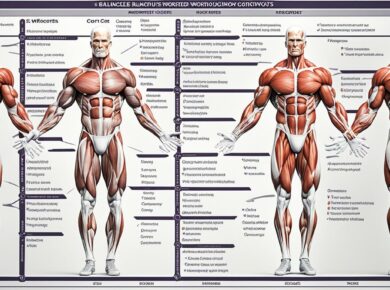Welcome to our comprehensive guide on designing regular workout routines! If you’re looking to kickstart your fitness journey, establish a consistent fitness routine, or enhance your current exercise schedule, you’re in the right place.
Our goal is to provide you with all the information you need to create a structured workout schedule that aligns with your goals, preferences, and available time. Because let’s face it, maintaining a healthy and active lifestyle is essential for your overall health and wellness.
Throughout this series, we’ll be covering various aspects of designing workout routines, including setting SMART goals, determining your available time for exercise, choosing your workout environment, incorporating compound exercises, including aerobic activities, adding strength training, balancing exercises for older adults, and much more.
So, whether you’re a fitness enthusiast or just starting out, we’ve got you covered. Let’s dive in and discover how you can design a fitness regimen that stands the test of time!
Setting SMART Goals for Your Workout Routine
When designing your workout routine, it’s important to set SMART goals to ensure your success. SMART is an acronym that stands for Specific, Measurable, Attainable, Relevant, and Timely. By setting goals that meet these criteria, you can stay focused and motivated throughout your fitness journey.
Specific
Specific goals state exactly what you want to achieve. Instead of saying, “I want to get in shape,” be more specific by saying, “I want to lose 10 pounds and improve my cardiovascular endurance.”
Measurable
Measurable goals allow you to track your progress. For example, instead of saying, “I want to get stronger,” set a goal to increase your bench press weight by 10 pounds within three months.
Attainable
Attainable goals are realistic and achievable. Assess your current fitness level and set goals that are challenging but within reach. It’s important to push yourself, but also be realistic about what you can accomplish.
Relevant
Relevant goals align with your interests and needs. Consider what is important to you and what you enjoy doing. Setting goals that are relevant to your lifestyle will increase your chances of sticking to your workout routine.
Timely
Timely goals have a specific timeline for completion. Instead of saying, “I want to run a marathon someday,” set a goal to complete a 10K race within six months. Having a deadline helps create a sense of urgency and keeps you on track.
By setting SMART goals, you can establish a clear direction for your workout routine. Whether your goal is to lose weight, build strength, improve endurance, or enhance overall fitness, having specific, measurable, attainable, relevant, and timely goals will keep you focused and motivated.
Determining Your Available Time for Exercise
When it comes to creating a regular workout routine, one of the most important factors to consider is the amount of time you can dedicate to exercise. Whether you have a busy schedule or limited free time, finding ways to incorporate physical activity into your daily routine is essential for maintaining a healthy lifestyle.
Assessing your available exercise time is key to designing a workout plan that fits your needs and preferences. Whether you can commit to a daily exercise routine or can only squeeze in a couple of sessions per week, it’s crucial to make the most of the time you have.
Research suggests that even shorter bouts of exercise throughout the day can be as effective as longer continuous sessions. So, if you only have 10 or 15 minutes at a time, don’t underestimate the impact it can have on your health and fitness goals.
By understanding your exercise time constraints, you can develop a realistic and achievable weekly workout schedule that accommodates your lifestyle. Remember, consistency is key, so aim for a routine that you can stick to in the long run.
To help you visualize and plan your weekly exercise program, here’s a sample workout schedule:
- Monday: 30 minutes of cardiovascular exercise (e.g., running, biking, or swimming)
- Tuesday: Rest day
- Wednesday: 20 minutes of strength training (e.g., weightlifting or bodyweight exercises)
- Thursday: 30 minutes of aerobic activity (e.g., dancing or HIIT workouts)
- Friday: Rest day
- Saturday: 30 minutes of yoga or flexibility exercises
- Sunday: Rest day
Feel free to adjust and customize this sample workout schedule based on your preferences and available exercise time. The key is to find a balance that works for you and supports your fitness goals.
Remember, the most important thing is to prioritize your health and well-being. Even if you can only spare a few minutes each day, making exercise a consistent part of your routine can have a significant impact on your overall fitness and quality of life.
Choosing Your Workout Environment
When it comes to working out, the location you choose can have a significant impact on the type of exercises you engage in. Whether you prefer the convenience of a gym, the comfort of your own home, or the fresh air of outdoor exercise, there are various options to consider when creating a structured workout schedule.
Sometimes, the gym provides access to a wide range of equipment and specialized classes, making it ideal for strength training and more intense workouts. Gyms offer a supportive environment with trainers and fellow fitness enthusiasts.
On the other hand, working out at home can be convenient and cost-effective. You can design your own exercise space and have the flexibility to choose from a variety of home workout programs and online fitness classes.
If you enjoy being outdoors, there are numerous activities that can be incorporated into your workout routine. Whether it’s running, cycling, hiking, or outdoor sports, exercising in nature can bring a refreshing change of scenery while providing an effective workout.
Remember to consider your preferences, convenience, and the resources available to you when choosing your workout environment. Find a location that motivates you and fits seamlessly into your lifestyle, ensuring that you can stick to your regular workout routine and achieve your fitness goals.
Incorporating Compound Exercises
When it comes to maximizing your workout routine and targeting multiple muscle groups, incorporating compound exercises is key. These exercises involve using multiple joints and muscle groups simultaneously, allowing for greater efficiency and effectiveness in your workouts.
Some popular compound exercises include:
- Squats
- Deadlifts
- Push-ups
- Pull-ups
These movements engage a variety of muscle groups, including your legs, glutes, core, chest, back, and arms. By incorporating these compound exercises into your routine, you can achieve a full-body workout and see improvements in aerobic endurance, muscular fitness, and flexibility.
Whether your goal is weight loss or muscle gain, compound exercises are a beneficial addition to any fitness program. Not only do they provide a time-efficient way to work multiple muscle groups, but they also help improve overall strength and functional fitness.
Remember to prioritize proper form and technique when performing compound exercises, as they can be challenging. Start with lighter weights or modifications if needed and gradually increase the intensity as your strength and confidence grow.
Including Aerobic Exercise
Aerobic exercise is an essential component of any regular workout routine. Engaging in aerobic activities such as walking, biking, running, and swimming offers numerous benefits to your overall health and fitness. Not only does aerobic exercise help you burn calories and manage your weight, but it also improves cardiovascular endurance and reduces the risk of various diseases.
The Physical Activity Guidelines for Americans recommend incorporating at least 150 minutes of moderate aerobic activity or 75 minutes of vigorous aerobic activity into your weekly routine. Moderate-intensity activities, like brisk walking or cycling, elevate your heart rate and breathing but still allow you to carry on a conversation. On the other hand, vigorous-intensity activities, such as running or swimming laps, significantly increase your heart rate and breathing, making it challenging to talk comfortably.
Alongside aerobic exercise, it is also important to include additional strength training sessions throughout the week. Strength training exercises help build muscle, increase bone density, and improve overall strength and endurance. Aim to engage in strength training exercises that target all major muscle groups at least two times a week to maximize your fitness results.
By incorporating both aerobic exercise and strength training into your regular workout routine, you can achieve a well-rounded fitness program that benefits your cardiovascular health, builds strength and muscle, and supports your overall well-being.
Adding Strength Training
Strength training is a vital component of any well-rounded workout routine. Not only does it help build muscle, but it also improves body composition and enhances overall physical strength. Incorporating resistance exercises that target all major muscle groups at least two times a week can help you achieve optimal results.
When designing your strength training program, aim for one set of each exercise, gradually increasing the weight or resistance level to challenge your muscles. This progressive overload is essential for continued growth and improvement. By consistently challenging yourself, you can make significant strides in your strength and endurance.
Resistance exercises can include weight lifting, the use of resistance bands, or bodyweight exercises that require you to work against gravity. These exercises engage specific muscle groups, such as the chest, back, legs, and arms, developing strength and definition. Remember to prioritize proper form and technique to prevent injuries and ensure maximum effectiveness.
Strength training not only helps you build muscle mass but also boosts your metabolism, aids in weight management, and improves bone density. It is especially crucial as you age, as it can help counteract muscle loss and maintain independence and mobility.

Balancing Exercises for Older Adults
For older adults at risk of falls, incorporating balance exercises into their regular workout routine is crucial. These exercises not only help improve balance, coordination, and flexibility but also reduce the risk of injuries. Engaging in activities such as tai chi, yoga, and Pilates can be particularly beneficial for older individuals, promoting functional strength and independence.
Balance exercises focus on challenging the body’s stability by shifting weight, performing single-leg movements, and maintaining equilibrium. These exercises help older adults maintain their mobility and prevent falls, which can have severe consequences for their overall health and well-being.
One effective and popular option for balance exercises is tai chi. This ancient Chinese martial art combines slow, graceful movements with deep breathing and relaxation techniques. Tai chi enhances balance, core strength, and body awareness, making it an ideal exercise for older adults.
Yoga is another excellent choice for older individuals looking to improve their balance and flexibility. By practicing various poses and sequences, yoga helps develop stability, body control, and muscle strength. Additionally, yoga encourages relaxation and stress reduction, which can further contribute to overall well-being.
Pilates is a low-impact form of exercise that focuses on core strength, stability, and flexibility. It incorporates controlled movements and precise breathing techniques, targeting deep muscles that support balance and posture. Regular Pilates practice can help older adults improve their balance and body alignment.
Remember to consult a healthcare professional or a certified fitness instructor before starting any new exercise regimen, especially if you have any existing health conditions or concerns.
Designing Your Fitness Program
When it comes to designing your fitness program, it’s crucial to consider your specific fitness goals and create a balanced routine. By incorporating various types of exercises, you can target different areas of your body and achieve a well-rounded workout.
Setting Clear Fitness Goals
Before starting your fitness journey, it’s important to define your specific fitness goals. Whether you want to lose weight, build muscle, improve cardiovascular endurance, or enhance overall fitness, having clear goals will help guide your exercises and measure your progress.
Creating a Balanced Routine
A balanced routine should include a combination of aerobic activities, strength training exercises, and flexibility exercises. Aim for at least 150 minutes of moderate aerobic activity or 75 minutes of vigorous aerobic activity per week to improve cardiovascular health and burn calories.
- Include strength training exercises for all major muscle groups at least two times per week. This can include weight lifting, resistance band workouts, or bodyweight exercises.
- Don’t forget to incorporate flexibility exercises such as yoga or stretching to improve joint mobility and prevent injuries.
Optimizing Exercise Duration and Rest
When determining the duration of your workouts, it’s important to start gradually and gradually increase the intensity and duration of your exercises. This allows your body to adapt and avoid overexertion. Remember to listen to your body and give yourself enough rest and recovery time between workouts.
By designing a fitness program that aligns with your goals, includes a balanced routine, and incorporates proper exercise duration and rest, you’ll be on your way to achieving your desired fitness level.
Conclusion
Designing and maintaining regular workout routines is the key to achieving your fitness goals and living a healthy lifestyle. By setting SMART goals, making the most of your available time, incorporating a variety of exercises, and considering your specific needs, you can create a fitness program that lasts.
Start slow and gradually increase the intensity and duration of your workouts. Listen to your body and give it the time it needs to adapt and recover. Remember, consistency is the key to making exercise a lifelong habit.
Regular physical activity not only improves your physical health but also has numerous mental and emotional benefits. It can help reduce stress, boost mood, and increase overall well-being. So, embrace regular workout routines as a part of your healthy lifestyle and enjoy the journey to a stronger and fitter you!






